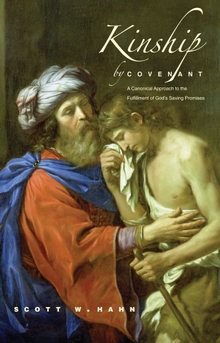Variations in Abrahamic Covenant Commentary
By Scott W. Hahn —
Unlike the Noahic covenant, the Abrahamic covenant has always been a focus of scholarly attention. Perhaps the most important recent contribution is Paul R. Williamson’s monograph, Abraham, Israel and the Nations (2000). Williamson, a synchronic and narrative analyst, recognizes that at least two covenants between God and Abraham are recorded in Scripture: Genesis 15 and 17. Williamson demonstrates that the treatment of “the” Abrahamic covenant is one of the rare instances in which diachronic analysts are more guilty of conflation and harmonization than their synchronic counterparts. Specifically, since most source-critical exegetes believe Israel only remembered one Abrahamic covenant preserved in two versions (Gen 15 [JE] and Gen 17 [P]), the two accounts are often theologically conflated and harmonized, usually to the detriment of an accurate reading of Genesis 17.
On the contrary, Williamson argues that the Genesis narrative presents these two incidents as referring to two distinct covenants with Abraham. Each takes up an aspect of the promises given in Genesis 12:1–3: Genesis 15 relates to the promise of nationhood, Genesis 17 to the promise of a “great name” and international blessing to all peoples. Following T. D. Alexander (1997), Williamson sees in Genesis 17 a conditional covenant promised, but not ratified until after the binding of Isaac. There on the mountain, after the testing of Abraham’s commitment to “walk blamelessly before me” (Gen 17:1), God gives Abraham a self-sworn oath to fulfill his promises to him, particularly the promise of blessing to all the nations (Gen 22:16–18).
While not all will be convinced by his treatment of Genesis 17 vis-à-vis Genesis 22, Williamson has performed a service by highlighting and questioning the commonly held assumption that the differences between Genesis 15 and 17 are without significance from the perspective of the final redaction of the text, and by pointing out the climactic nature of Genesis 22:16–18 in the canonical narrative. The present study builds on Williamson’s insights to flesh out a fuller picture of the relationship among the covenants of Genesis 15, 17, and 22 with each other and with the divine promise of Genesis 12 (see Chapter 5).
Williamson’s work stands in contrast to an analysis of the covenant theme in the Pentateuch by Graham Davies (2003). Davies devotes most of the first half of his essay to the question why, in the course of the Pentateuch, there is a transition from language about “covenant” to language about the “oath to the fathers.” Davies reviews several different explanations and arrives at mixed conclusions. Williamson’s analysis of the Abraham cycle, which points to the climactic nature of the oath to Abraham in Genesis 22:15–18 (the only divine oath to any patriarch) as the confirmation of all previous Abrahamic covenantpromises (i.e., Gen 12:1–3; 15:1–21; 17:1–22) may have provided Davies with the solution to his investigation.
The rest of Davies’ essay analyzes covenant in the Holiness Code, specifically Leviticus 26. Davies’ work is similar in method and conclusions to a more detailed study by Jacob Milgrom (2004), who undertakes analysis of both the Abrahamic (better: “Patriarchal”) and Sinaitic covenants from the perspective of the Holiness Code. Milgrom believes the Holiness school was aware of the covenant traditions of J, E, and P, and Leviticus 26 presupposes knowledge of each of them. All the occurrences of bĕrît in Leviticus 26 (the conclusion of the Holiness Code) refer to the Sinaitic covenant, with the exception of v. 42. In Milgrom’s view, the Holiness school understood both the patriarchal and the Sinaitic covenants as conditional—in our terminology, treaty rather than grant-type covenants. But Milgrom’s ultimate concern is not with covenant theology but with dating literary strata, especially the Holiness Code. He wishes to prove that the bulk of Leviticus 26, contrary to consensus, did not arise in the postexilic period when the supposed “unconditional” covenant with the patriarchs was understood to be the basis for the return from the Exile. In his view, the Holiness School viewed the covenant with the patriarchs and the Sinai covenant as essentially the same, both requiring Israel’s obedience.
Milgrom’s analysis is full of brilliant exegetical insights on particular passages (e.g., his treatment of hēqîm mentioned above), yet the broader usefulness of his contribution is hampered by the ubiquity of his meticulous, but idiosyncratic, source criticism and his narrow focus on “H”—a school and tradition whose very existence is denied by some (notably Rendtorff). Surprisingly, his discussion of the “Abrahamic” covenant takes almost no notice of Genesis 12:1–3, 15:12–21, or 22:15–18, all of which are more or less unconditional in their formulation, despite the fact that he believes the Holiness redactor was well aware of these traditions. Nonetheless, Milgrom’s work mounts a plausible and well-argued challenge to traditional assumptions concerning the source-critical analysis of the Priestly and Holiness materials related to covenant.
From Kinship by Covenant by Scott W. Hahn. Published by Yale University Press in 2019. Reproduced with permission.
Scott W. Hahn holds the Fr. Michael Scanlan Chair of Biblical Theology at Franciscan University of Steubenville. Author or editor of over forty books, he is founder and president of the St. Paul Center for Biblical Theology, and editor-in-chief of Emmaus Academic Publishing.
Further Reading:



























